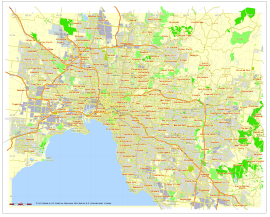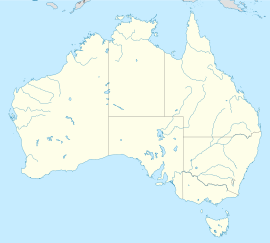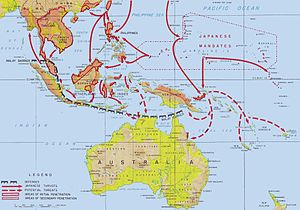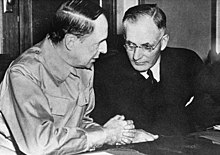world.wikisort.org - Australia
Naval Base Melbourne was a United States Navy base at Melbourne, Australia during World War II. Naval Base Melbourne became the South West Pacific Area Command Headquarters after the 1941 invasion of the Philippines. General Douglas MacArthur, after escaping the Philippines, set up his Headquarters after his arrival on March 21, 1942. MacArthur was appointed Supreme Commander of all Allied Forces in the South West Pacific Area. The US Navy also set up a Headquarters a Melbourne, Allied Naval Forces Southwest Pacific Area under Commander Vice Admiral Herbert F. Leary.[2] MacArthur and Leary used the empty Trustees Executive building at 401 Collins Street, Melbourne for headquarters. The Port of Melbourne had good fleet anchorage and docks. A new naval base was built at Brisbane, Australia, Naval Base Brisbane, and the Headquarters was moved to Brisbane in July 1942.[3][4][5]
| Naval Base Melbourne Victoria | |
|---|---|
(1942-1945) | |
 Map of Melbourne, Australia | |
 Naval Base Melbourne | |
| Coordinates | 37.817153°S 144.961093°E |
| Established | March 21, 1942 |
| Elevation | 31 m (102 ft) |
| Time zone | AEST (UTC+10) |
| • Summer (DST) | AEDT (UTC+11) |

![An Australian propaganda poster from 1942 referring to the threat of Japanese invasion. This poster was criticised for being alarmist when it was released and was banned by the Queensland government. Japan did have a plan.[1]](http://upload.wikimedia.org/wikipedia/commons/thumb/f/f1/Coming_South_%28AWM_ARTV09225%29.jpg/220px-Coming_South_%28AWM_ARTV09225%29.jpg)


History
With the loss of Naval Base Manila in 1941, the US Navy and United States Army need a safe South West Pacific port to stage a reply to Empire of Japan advances. Northern Australia ports were within reach of Japan long-range bombers. Bombing of Darwin on February 19, 1942, demonstrated a more southern port was needed. Melbourne, in southern Australia, was far away from any current or future attacks. The existing port facilities at Melbourne were large enough to support the staging of future action. Local civilians were hired to help in the unloading and loading of US Navy and US Army ships. Japan planned an invasion of Australia, but after the losses at the Battle of the Coral Sea Japan canceled these plans. The SS President Coolidge and SS Mariposa arrived at Melbourne on February 1, 1942 with supplies and munitions for the base and Australia. The ship also had troops and crafted P-40. The crew's leaders were sometimes called the "Remember Pearl Harbor" (RPH) Group or RPH staff.[6][7] Other ships that were heading to now captured or in danger Pacific ports arrived at Melbourne. Melbourne became a staging place for 1942 convoys. On July 16, 1942 the SS Matsonia arrived at Melbourne with troops, most camped at Camp Murphy. The Melbourne Cricket Ground was used to house the staging of American and Australian troops, called Camp Murphy. The USS West Point (AP-23) arrived Sept. 4, 1942 with more troops for Camp Murphy.[8][9] US Army set up a camp at Victoria Barracks, Melbourne. MacArthur set up his HQ at first in the Hotel Australia. After the Battle of the Coral Sea, in May 1942, and the Battle of Midway in June 1942, the US Navy and Army later moved its Headquarters to Naval Base Brisbane in July 1942. Melbourne also became a rest and recuperation spot for US troops after Pacific War battles. The 1st Marine Division, 865 Officers and 17,335 men, rested at Melbourne after the Battle of Guadalcanal arriving on January 12, 1943 on the USS West Point (AP-23), protected by the USS Bagley (DD-386). Rest camps were Camp Robinson, Camp Murphy, Convalescent Camp Pell, Camp Balcombe, Mount Martha, and at Ballarat.[10] Naval Base Melbourne was closed after the war.[11][12]
Geelong depot
Near Melbourne at Geelong, the US built a new ammunition depot. The Geelong depot was later named Kane Ammunition Depot, after a US Army 453d Ordnance Company crew member, who died in a convoy that departed Melbourne on January 27, 1942. His ship, Don Isidro was going to Corregidor in Manila to help the troops there. But in north Australia, his ship was attacked and ground on Bathurst Island, north of Darwin. Kane died in a Australian hospital at Darwin. Kane Ammunition Depot was run by the 25th Ordnance Medium Maintenance Company. The depot worked with the Townsville Naval Section Base, which had an Anti-aircraft Ordnance Training Center. The depot was closed after the war and is still abandoned today.[13][14]
- Small depots were built at Melbourne suburbs: Seymour, Laverton and Kensington.[15]
Rowville Training Camp
At Rowville a US Marine training camp was built in May 1943, with support from the US Navy. The 1st Marines trained at the camp. Marines trained on field exercises live overhead firing, machine gun use, and mortar use.[16] The camp was built by the Seabee 19th Battalion. The 19th Battalion also were the teachers of the use of some of the heavy equipment for the 17th Marine Engineering Regiment. In July 1943 the 3rd Battalion of the 17th Marines moved to Naval Base Cairns. The camp closed September 30, 1943 after the departure of the 7th Marines, 1st Battalion and 4th Battalion of the 11th Marines. Most of the camp is now a major electrical terminal station and Stud Park. The camp was at 37.928°S 145.230°E.[17]
Prisoner of war camps
In 1944 Prisoner of war Camp, Rowville POW Hostel, was built that house 300 Italian Prisoners. A small hospital was built at the site in 1945. Italian infantryman Private Rodolfo Bartoli, from Firenze, Italy tried to escape and was shot on March 29, 1946. The POW camp closed in 1946.[18] In 1940 camps were also built at Tatura, two camps at Tatura and two at Rushworth for German and Italian.[19][20]
Melbourne Convoys

- Convoy MS-5 departed Melbourne on February 22, 1942. The convoy's goal was to reinforce the Netherlands East Indies. The Convoy included: MS Sea Witch with crafted Curtiss P-40 Warhawk aircraft, HMAS Katoomba, MV Duntroon, USAT Willard A. Holbrook and USS Langley (CV-1) that was sunk on the trip. The USS Whipple (DD-217) and USS Edsall (DD-219) joined the Convoy for added protection. The Troop ship Willard A. Holbrook had the US Army’s 35th and 51st Pursuit Groups onboard. Empire of Japan two-engine naval land attack planes and six fighters attacked the convoy 74 miles from Tjilatjap on February 27. Sixteen men from Langley died. The USS Pecos (AO-6) took on some of the survivors of the Langley.[21][22][23]
- The convoy of ships with Troops and Curtiss P-40 Warhawk reached Melbourne on February 1, 1942 and departed for Perth on February 2. The convoy was to go to India, but due to the invasion Philippines, the convoy returned to San Francisco.[24]
- On February 26, 1942, the ships of Task Force 6814, with seven transport ships arrived at Melbourne harbor. Stayed in camps in and outside of city: Ballarat, Bendigo, Darley, Royal Park and Melbourne.[25] Many Australians opened their home and the Troops had home-cooked meals. The Task Force reloaded and departed for New Caledonia on March 6.[26][27]
- Regular Convoys were started each with a code CO was for Newcastle to Melbourne and Adelaide ran from June 1942 to Dec. 1943 with 150 convoys, reverse trip called, OC. Convoy MS was from Melbourne to Singapore ran Jan. 1942 to March 1942 to support the British-led forces facing the Japanese invasion; 4 convoys. Convoy PV was from Melbourne to Townsville ran Sept. 1943 to Oct. 1943.
- Some ships that ports in Melbourne :USS General H. W. Butner (AP-113), USS Mount Vernon (AP-22), USS Victoria (AO-46), USS General George M. Randall (AP-115), SS America (1939), USS General W. A. Mann (AP-112), USS Altamaha (CVE-18), USS General John Pope (AP-110), USS Susan B. Anthony (AP-72), USS Yuma (AT-94), USS Phoenix (CL-46), USS General W. F. Hase (AP-146), SS President Cleveland (1920), USS General A. W. Greely (AP-141), , USS Admiral W. S. Benson, USS Altamaha (CVE-18), USS ARD-10 to repair ships and others.
Naval Intelligence Center
Station CAST was Naval intelligence center at Naval Base Cavite. With the fall of the Philippines the center was moved to Naval Base Manila's Corregidor Island. US Navy Cryptologists and other Naval intelligence personnel were taken off Corregidor Island by submarines on April 8, 1942 after the fall of Manila. Not all troops on Corregidor were evacuated, many became Prisoner of war and part of the Bataan Death March. The team set up a Naval Intelligence Center at Melbourne. The CAST team joined the Royal Australian Navy codebreakers at Melbourne. The two units became Fleet Radio Unit, Melbourne. To be low key the unit was based in the Monterey Apts on Arthur Street and the Moorabbin Town Hall.[28][29] US Navy Communication Security Section of the Office of Naval Communications, since 1940 was able to decode some Japanese communication ciphers and codes. By March 1942 the center was able to decipher up to 15% of the Imperial Japanese Navy's Naval Codebook D, (US Navy label "JN-25B"). By May 1942 the US Navy was decoding up to 85% of the Ro code sent by Japan's Navy.[30]
Fleet Radio Unit Radio Station
Naval Base Melbourne supported a remote post, Fleet Radio Unit Radio Station, at Adelaide River. The post was called USN Supplementary Radio Station Adelaide River and U.S. Naval Attachment, Fleet Radio Unit, Navy 136. It was run under the United States Seventh Fleet for the Naval Intelligence Center and opened in March 1943. A teleprinter line was run to Naval Intelligence Center so the info picked up could get to Naval Intelligence Center quickly. A DAB-3 HFDF was installed, a radio Direction Finding System, or Radio Direction Finder (RDF). The site was abandoned after the war. The Fleet Post Office FPO was 179 SF Adelaide River, Australia. Fleet Radio Unit Radio Station was supported by Naval Base Darwin .[31][32]
Airfields
The US Navy and other branches made some use of existing Airfields in Melbourne:
- Tullamarine Airfield now Melbourne Airport
- Essendon Airfield now Melbourne Essendon Airport
- Avalon Airport at Geelong depot
- Ballarat airfield now Ballarat Airport
- RAAF Base Point Cook Airfield 20 km (12 miles from Melbourne), also home to RAAF Museum at Point Cook.
- The Commonwealth Aircraft Corporation built aircraft and was used to reassemble crated aircraft arriving from the United States on US Navy ships.
- Department of Aircraft Production built aircraft Melbourne.
- Outlining Airfields:
- Lake Boga, Victoria Seaplane base
- Wangaratta Airport
- Werribee Airfield
Battle of Melbourne
While most people in Melbourne welcomed the US arrival at Melbourne, problems between Australian Troop and US Troop peaked in 1942 and caused was is called the Battle of Melbourne on December 1, 1942. The Battle of Melbourne was a smaller riot between Australian Troops and US Troops. There were riots in Brisbane, Bondi on February 6, 1943, Perth in January 1944 and Fremantle in April 1944. During the war there was a news blackout of the event, due to the need to keep morale up.[33][34]
Post war
- After Victory over Japan Day the base closed and the US Navy started taking Troops home in Operation Magic Carpet.
- At Ballarat Gardens near Lake Wendouree is a marker plaque that reads:[35]
- "A tree that looks at god all day And lifts her leafy arms to pray. United States Marine Corps 1st Marine Division. This tree is to commemorate the Friendship established between The United States Marine and The citizens of Ballaarat during Their sojourn in early 1943"
- At Rowville's Stud Park is a marker noting the spot of the Rowville camp and the 1944 Italian Prisoner of war Camp.[36]
- Shrine of Remembrance in Melbourne.
- Melbourne Holocaust Museum is in Elsternwick, Victoria opened in 1984.
- Australian National Aviation Museum in Tyabb just south of Melbourne.
- Old Aeroplane Company Museum in Tyabb just south of Melbourne.
See also
- Naval Base Adelaide
- US Naval Advance Bases
- Eastern Area Command (RAAF)
- HM Naval Dockyard Williamstown
- US Naval Base Australia
External links
- youtube When World War 2 Came to Melbourne on 26 February, 1942
- youtube MaCarthur In Australia (1942)
- youtube Visions Episode 71: US Marines in Wartime Melbourne
References
- Peter Stanley (2002), pg 3.
- Allied Naval Forces Southwest Pacific ozatwar.com
- AAF Melbourneozatwar
- South West Pacific Area (command)ozatwar
- Melbournepacificwrecks.com
- Mayo, Lida (1991). The Ordnance Department: On Beachhead And Battlefront. United States Army In World War II — The Technical Services. Washington, DC: Center Of Military History, United States Army. p. 40. LCCN 67-60000.
- Matloif, Maurice; Snell, Edwin M. (1991). Strategic Planning For Coalition Warfare 1941–1942. United States Army In World War II — The War Department. Washington, DC: Center Of Military History, United States Army. p. 132. LCCN 53-61477.
- Camp Murphyozatwar.com
- 1942 Troop Shipsww2troopships.com
- 1st Marine Divisionozatwar.com
- Frei, Henry P. (1991). Japan's Southward Advance and Australia. From the Sixteenth Century to World War II. Melbourne: Melbourne University Press. ISBN 0-522-84392-1.
- Stanley, Peter (2008). Invading Australia. Japan and the Battle for Australia, 1942. Melbourne: Penguin Group (Australia). ISBN 978-0-670-02925-9.
- Early Arrivals in Australia US Army
- Kane Ammunition Depotozatwar.com
- US Army Australia
- Marines at Melbourne pacificwrecks.com
- Rowville Training Campozatwar.com
- Rowville POW campozatwar.com
- The forgotten history of Australia’s prisoner of war camps, by MATT YOUNG & CHARIS CHANG, April 25, 2014 heraldsun.com.au
- Italian POWs
- US Navy, American and Australian Cooperation in the Battle of the Coral Sea
- Convoy MS-5convoyweb.org
- Hattori, Takushiro (1980) [1949]. "Statement Concerning Reasons for Opposition to Plan for Invasion of Australia". In Donald S. Detwiler (ed.). War in Asia and the Pacific. Volume 7. The Southern Area (Part II). New York: Garland Publishing. ISBN 0-8240-3291-8.
- convoy February 1, 1942sea.museum
- Royal Park, Melbourneinnercitynews.com.au
- 182ndinfantry.org182ndinfantry.org
- Task Force 6814 US Navy
- Naval Supplementary Radio Station Melbourne Australia stationhypo.com
- Fleet Radio Unit, Melbournenavycthistory.com
- Parker 2017, pp. 18–21; Willmott 2002, pp. 21–22; Parshall & Tully 2005, p. 60. For unknown reasons, the IJN postponed making their scheduled change of the Ro code from 1 April to 1 to 27 May 1942 (Willmott 2002, pp. 21–22; Lundstrom 2006, p. 119). The U.S. operated Fleet Radio Units in Washington, D.C., Pearl Harbor and, with the Australians, at Melbourne (Prados 1995, pp. 300–303).
- DAB-3 HFDFcryptomuseum.com
- USN Supplementary Radio Station Adelaide Riverozatwar.com
- Raymond Evans and Jacqui Donegan, "The Battle of Brisbane", Politics and Culture.
- Peter Dunn, 2005, "The Battle Of Brisbane – 26 & 27 November 1942" Archived 10 January 2008 at the Wayback Machine (Australia @ War) Accessed 15 December 2006
- Ballarat Gardens plaque ozatwar.com
- Marker of the Rowville POW campozatwar.com
Другой контент может иметь иную лицензию. Перед использованием материалов сайта WikiSort.org внимательно изучите правила лицензирования конкретных элементов наполнения сайта.
WikiSort.org - проект по пересортировке и дополнению контента Википедии

